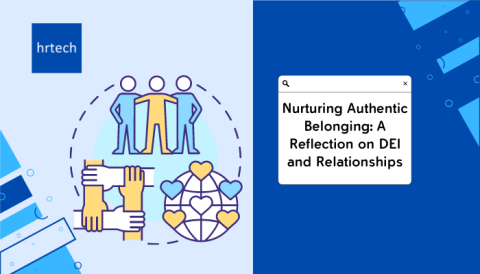Did you know? According to a survey report, more than 7 in 10 employees have already highlighted that their companies are making progress towards implementation of DEI in the workplace.
DEI stands for Diversity, Equity, and Inclusion, which are three interrelated concepts that are increasingly important in the workplace.
Read on to explore what DEI exactly means, why it’s important, its benefits, challenges, implementation steps, and more.
What Does DEI Stand For In The Workplace?
DEI stands for Diversity, Equity, and Inclusion. These are three key components of a healthy and productive workplace environment.
Diversity refers to the range of differences among people like race, gender, ethnicity, age, and religion, and more.
Equity refers to ensuring that everyone has access to the same opportunities and resources, regardless of their background or identity.
Inclusion refers to creating a sense of belonging and community for all employees, regardless of their differences.
A workplace that follows DEI is one where every employee feels valued and supported. Everyone has an equal opportunity to succeed. This benefits both individual employees, and also the organization as a whole, as it promotes creativity, innovation, and collaboration.
Why Is DEI Important?
Diversity, Equity, and Inclusion (DEI) are essential elements of any successful organization because they create an inclusive and supportive environment for all employees, regardless of their background, race, or gender.
Organizations can benefit in several ways by successfully implementing DEI initiatives.
For instance, DEI initiatives can help organizations attract and retain top talent. In today’s competitive job market, employees are looking for workplaces that prioritize diversity and inclusivity.
With the successful implementation of DEI programs, organizations can demonstrate their commitment to creating a welcoming and supportive workplace for all employees.
Furthermore, DEI initiatives can help organizations encourage innovation and creativity.
When employees from diverse backgrounds come together, they bring unique perspectives and experiences into the team. This diversity of thought can lead to new ideas and solutions that might not have been possible otherwise.
DEI initiatives can also help organizations improve profits. Studies show that companies with more diverse workforces tend to be 27% more profitable than those without.
With a more diverse and inclusive workplace, companies can access a broader range of perspectives and ideas, which can lead to better decision-making and more significant business outcomes.
Examples of DEI Initiatives
1. Unbiased Hiring Practices
Unbiased hiring practices are essential to creating a diverse workforce.
Companies can ensure that their hiring practices are unbiased by removing identifying information such as names from resumes and using structured interviews that focus on job-related skills and experience more.
2. Employee Resource Groups (ERGs)
Employee Resource Groups (ERGs) are voluntary, employee-led groups that promote diversity and inclusion in the workplace.
ERGs provide a platform for employees to connect with others who share similar backgrounds or interests and can help foster a sense of belonging and community within the workplace.
3. Mentorship and Sponsorship Programs
Mentorship and sponsorship programs can help underrepresented employees advance their careers by providing them with guidance, support, and opportunities for professional development.
These programs can also help to create a more inclusive workplace culture by promoting diversity and recognizing the value of different perspectives and experiences.
4. Talent Development Programs
Talent development programs can help employees from underrepresented communities develop the skills and experience they need to advance their careers.
Companies can offer training and development programs that focus on building skills such as leadership, communication, and problem-solving, and provide opportunities for employees to gain experience through job rotations or stretch assignments.
5. Supplier Diversity Programs
Supplier diversity programs can help companies build relationships with businesses owned by underrepresented groups and support economic development in diverse communities.
These programs can include initiatives such as setting goals for spending with diverse suppliers, providing training and resources to help diverse suppliers grow their businesses, and tracking and reporting progress towards diversity goals.
Benefits Of DEI
Diversity, Equity, and Inclusion (DEI) is a crucial aspect of any organization. It fosters an environment that is welcoming, inclusive, and respectful of all employees, regardless of their background. Here are some of the specific benefits of DEI:
1. Improved Employee Engagement
DEI initiatives help create a sense of belonging among employees, which leads to higher engagement levels.
When employees feel valued and respected, they are more likely to be invested in their work and the success of the organization.
2. Increased Innovation
A diverse workforce brings a variety of perspectives and experiences to the table, which can lead to innovative solutions and ideas.
DEI initiatives help organizations get access to the full potential of their workforce and encourage creativity and innovation.
3. Better Decision Making
Diverse teams are better equipped to make informed decisions.
When a group of people with different backgrounds and experiences come together to solve a problem, they are more likely to consider a wider range of perspectives and come up with a more comprehensive solution.
4. Improved Company Reputation
Organizations that prioritize DEI are viewed as more socially responsible and progressive. This can help attract and retain top talent, as well as improve customer loyalty and brand reputation.
5. Enhanced Employee Retention
DEI initiatives help create a workplace culture that is supportive and inclusive, which can lead to higher employee retention rates.
When employees feel valued and respected, they are more likely to stay with the organization long-term.
Challenges Of Implementing DEI
Implementing DEI is a complex process that requires a significant amount of effort, resources, and commitment from organizations.
Here are the top five challenges that organizations face when implementing DEI:
1. Lack of Leadership Support
One of the biggest challenges in implementing DEI is getting leadership support.
Without the support of top-level executives, DEI efforts can easily become stagnant or fail. Leaders must be committed to DEI and lead by example to create a culture of inclusivity and diversity.
2. Resistance To Change
Another significant challenge in implementing DEI is resistance to change. Some employees may resist changes, such as changes in hiring practices or company culture.
Organizations must be prepared to address resistance to change and provide support to employees who may be struggling to adapt to new DEI initiatives.
3. Lack Of Diversity In Leadership
A lack of diversity in leadership can hinder DEI efforts.
When leadership is not diverse, it can be challenging to create a culture of inclusivity and diversity. Organizations must prioritize diversity in leadership roles to ensure that DEI initiatives are successful.
4. Unconscious Bias
Unconscious or hidden bias is another challenge that organizations face when implementing DEI. Implicit biases can prevent employees from effectively integrating DEI.
Organizations must offer training sessions on implicit biases to bring the subconscious to the conscious and make employees aware of their biases.
5. Measuring Success
Measuring the success of DEI initiatives can be challenging. Organizations must develop metrics to measure the effectiveness of their DEI efforts. This can include tracking diversity in hiring, employee engagement, and retention rates.
How To Implement DEI In The Organization?
To implement DEI in the organization, there are several steps that need to be taken as follows:
Step 1 – Define DEI
The first step in implementing DEI is to define what it means for your organization.
This involves understanding the different components of DEI, such as diversity, equity, and inclusion, and how they relate to your organization’s values and goals.
Step 2 – Assess The Current State
Once you have defined DEI, the next step is to assess the current state of your organization.
This involves gathering data on the diversity of your workforce, as well as identifying any barriers to inclusion that may exist.
Step 3 – Set Goals
Based on the assessment of your organization’s current state, the next step is to set goals for improving DEI.
These goals should be specific, measurable, achievable, relevant, and time-bound.
Step 4 – Develop a Plan
With goals in place, the next step is to develop a plan for achieving them.
This plan should include specific actions that will be taken to increase diversity, promote equity, and develop inclusion in the workplace.
Step 5 – Communicate the Plan
It is important to communicate the DEI plan to all employees in the organization. This includes explaining the goals, the actions that will be taken, and the expected outcomes.
Step 6 – Train Leaders
Leaders in the organization should be trained on DEI principles and practices. This includes understanding the importance of diversity, equity, and inclusion, as well as how to create a more inclusive workplace.
Step 7 – Train Employees
All employees should be trained on DEI principles and practices. This includes understanding the importance of diversity, equity, and inclusion, as well as how to create a more inclusive workplace.
Step 8 – Review Policies And Procedures
Policies and procedures should be reviewed to ensure they are aligned with DEI principles and practices.
This includes reviewing recruitment and hiring practices, as well as performance evaluation and promotion processes.
Step 9 – Create a Diversity Council
A diversity council can be established to provide guidance and oversight on DEI initiatives. This council should be representative of the entire organization and include employees from all levels and departments.
Step 10 – Create Employee Resource Groups
Employee resource groups can also be established to provide support and networking opportunities for employees from underrepresented groups.
These groups serve as a resource for the organization to better understand the needs and experiences of diverse employees.
Step 11 – Measure Progress
It is important to measure progress towards achieving the DEI goals that have been set. This includes tracking metrics such as workforce diversity, employee engagement, and retention rates.
Step 12 – Hold Leaders Accountable
Leaders in the organization should be held accountable for progress towards achieving DEI goals.
This includes setting expectations for their role in promoting diversity, equity, and inclusion, as well as holding them accountable for their actions.
Step 13 – Celebrate Success
When progress is made towards achieving DEI goals, it is important to celebrate success.
This includes recognizing individuals and teams that have contributed to the organization’s DEI efforts.
Step 14 – Resolve Challenges
Some challenges will arise when implementing DEI initiatives. It is important to resolve these challenges head-on and make adjustments to the plan as needed.
Step 15 – Continuously Improve
DEI is an ongoing process, and it is important to continuously improve. This includes regularly reviewing the DEI plan, assessing progress, and making adjustments as needed to ensure the organization is moving towards a more diverse, equitable, and inclusive workplace.
How To Measure The Success Of DEI Initiatives
One of the ways to measure the current state of DEI in an organization is by analyzing the workforce demographics.
It is essential to track the representation of different groups in the workforce, such as gender, race, ethnicity, age, and disability, to identify areas of underrepresentation and track progress towards achieving a more diverse and inclusive workplace.
Another metric that organizations can use to measure the success of DEI initiatives is employee engagement.
Measuring employee engagement can provide insight into how employees feel about the organization’s culture, policies, and practices. It can also help identify areas where the organization needs to improve to create a more inclusive workplace.
Organizations can also measure the success of DEI initiatives by tracking the representation of different groups in leadership positions.
This metric can help identify any barriers to advancement and ensure that the organization is providing equal opportunities for all employees to advance in their careers.
It is essential to establish clear goals and metrics for measuring the success of DEI initiatives.
As organizations track progress towards these goals, they can identify areas where they need to improve and make data-driven decisions to create a more inclusive workplace.
Here’s a quick overview of some of the metrics that organizations can use to measure the success of DEI initiatives:
| Metric: | Overview: |
| Workforce demographics | Analyzing the representation of different groups in the workforce |
| Employee engagement | Measuring how employees feel about the organization’s culture, policies, and practices |
| Representation in leadership | Tracking the representation of different groups in leadership positions |
| Turnover rates | Analyzing the turnover rates of different groups |
| Pay equity | Ensuring that employees are paid fairly regardless of their gender, race, or ethnicity |
| Training and development | Providing equal opportunities for employees to receive training and development |
| Supplier diversity | Ensuring that the organization’s suppliers are diverse and inclusive |
Final Thoughts
In short, DEI stands for Diversity, Equity, and Inclusion. It is an essential aspect of any organization that helps in creating a positive work culture.
With the successful implementation of DEI initiatives, companies can improve employee morale, promote business ethics, and drive creative problem-solving and innovation.Need more HR expertise for your company’s growth? Our talent-on-demand service is here to help. Reach out to us today!




